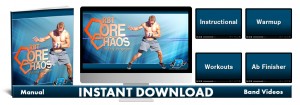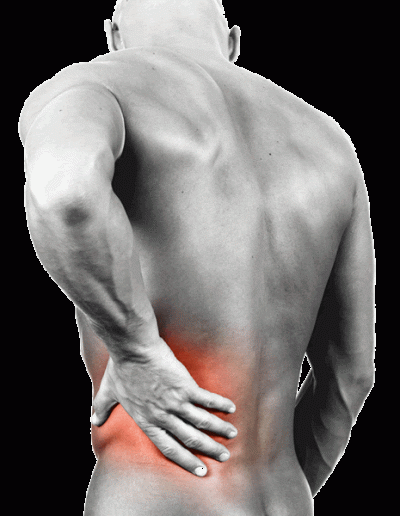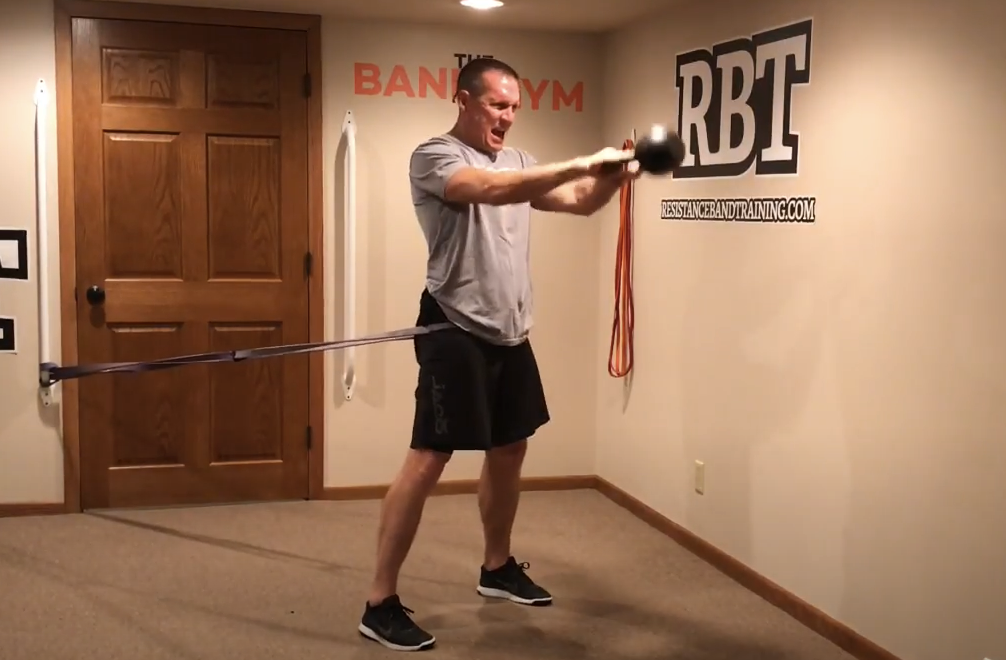Low Back Training Strategies that work to “Bullet-Proof” the most frequently injured area in the body.
The low back is positioned between the hips and mid-back. Understanding this anatomical position and how it relates to developing a “bullet-proof” low back training exercise routine is the key to keeping the most frequently injured region in the body feeling great and moving great regardless the age.
Fortunately to accomplish this it does not require being a physical therapist or having specialized equipment. With a little knowledge and a few Quantum Resistance Bands, bullet-proofing your low back is to build into a weekly workout routine.
Low Back Concepts That Need to Be Understood
Concept #1: The low back is a transition area for Reciprocal Movement
The body is designed around our ability to create locomotion of which walking and running are the most popular option. Knowing this, it’s important to understand the concept of “Reciprocal Movement” and how it impacts the low back.
When walking or running the opposite leg and arm work together by moving in a similar direction and in a similar plane. As an example when you step forward with your left leg, your right arm mirrors the forward movement. As a result your right leg and left arm are place in a backwards position relative to your torso. This is what is call “Reciprocal Movement”. With reciprocal movement, the left leg and right leg move in opposite directions and the forces that result from that go directly through the low back. Fortunately the arms mirror the legs which lessens the forces.
However if the body loses the ability to reciprocate due to lose of mobility and flexibility, it becomes very apparent that the low back will be dramatically impacted. As a result stretching and mobilization is going to be important to keeping your low back healthy.
Concept #2: The low back is positioned above the hip joints
Knowing the amount of standing and walking we do as individuals each day, over 75% of the body’s functional movements are driven from the ground up. Also knowing that the body functions in kinetic chain, the positioning of the low back above the hips becomes significant—especially if the hips have restricted range of motion.
A loss of flexibility and mobility in the hip joints as well as the surrounding muscles immediately places the burden of making up this movement loss on the low back which is the next joint above the hips in the kinetic chain.
Considering the low back anatomically does not have a great deal of natural range of motion, asking it to provide more is not a good long-term functional strategy and is what ultimately leads to excessive wear and tear to the low back disc and joint structures.
Concept #3: The low back is positioned below the mid-back and shoulders
If movement is not being driven from the ground up, it is being driven from the head down. To experience what is meant by this, put your feet tight together and swing your arms. You will immediately notice the rotations that occurs through your mid back and low back. This again is a result of the body being a total kinetic chain. As a result staying mobile through the mid-back and shoulder regions will decrease the amount of movement the low back will have to make up for and in turn put more stress on the low back disc and joint structures.
Unfortunately as the body ages it is the mid-back and shoulders that often become restricted first. As a result, movements that are driven by the upper extremities, like reaching, throwing and swinging, instantly challenges the low back to move more if the mid-back does not provide enough range of motion.
Considering how much reaching we do with our arms on a daily basis, keeping the mid back area mobile becomes critical to low back health.
Concept #4: The low back is stabilized from moving too far
The low back is stabilized and protected from moving too far by the core muscles, specifically the lower abdominals.
The best way to achieve optimal dynamic stabilization of the low back is by training the lower abdominals in a standing posture to take advantage of ground reaction forces that require the glutes to work with the abs. However, most individuals train the abdominals using lying or sitting postures doing movements like crunches,sit-ups or leg raises. These exercise actual increase low pressure on the disc and joint structures of the low back by forcing the low back to go through movement versus training stabilization. These movements also reinforce the use of the rectus abdominus which can not stabilize the low back due to its anatomical alignment.
To effectively protect the low back, training the abs in standing to be isometric and than dynamic reactive stabilizers of the low back are key to protecting the low back joints and disc from excessive movements outside their normal range of motion.
The body is going to move to accomplish the goal. If joints and muscles are weak or inflexible, other joints and muscle will be required to compensate. The Low Back is the #1 area of compensation because it is where all functional movement is driven from.
Low Back Training Strategies and Exercises that Work Using Resistance Bands
Strategy #1: Stretching and Mobilizing the Hips without Low Back Compensation
Bands are the perfect stretching tool when it comes to keeping the hip joints mobile and the surrounding muscles flexible. This can be easily accomplished by performing an active band stretching routine before every workout.
This stretching routine should address all planes of hip movement while making sure the stretching targets the key muscles while not allowing the low back to compensate which is often the case when using traditional body weight stretching.
Performed correctly, band stretching will allow both hips to be stretched and mobilized simultaneously following the exact kinetic chain patterns of movement used everyday with walking.
Remember, range of motion that is lost in the hips must be made up for in the low back. Maintaining mobile hips significantly decreases the likelihood of the low back being forced to make up for the lack of hip mobility and muscle flexibility.
Band Man’s Daily Stretching Routine
Strategy #2: Mobilizing the Mid-Back Early and Often
Resistance bands allow the shoulder and mid-back to be mobilized and lengthened out using a “distraction” technique that creates elongation while having the body move around a fixed arm. Both of these band stretching techniques make it very easy for the mid-back and shoulder to get stretched and mobilized without creating unnecessary stress to the low back and shoulder.
Keeping good mobility through the mid-back decreases the likelihood of the low back having to once again make up for lost range of motion in surrounding joints. A band shoulder stretching routine(shown below) should be an exercise routine that is applied before any upper body strength workout.
Shoulder Stretching Series
Strategy #3: Build rotational movements into every exercise program
Assuming hip, mid-back and shoulder rotation is being addressed using the previously mentioned solutions, the next important low back training strategy should be to incorporate rotational type movements into every workout.
This will ensure that the newly gained mobility in the hips and mid-back becomes usable mobility.
Unlike free weights, Resistance bands are able create horizontal vector forces which in turn provide the perfect training set up to easily bring in rotation while in a standing posture. Using a horizontal force allow rotation to be brought into a basic lunge, row, push, press or squat movement. By bringing in rotation to your strength training program, it allows you to combine up strength and mobility training into a single exercise.
Ways to Bring in Rotation to Your Workout using RBT
Strategy #4: Train Both Static as well as Reactive Core Stabilization
The key to protecting the low back is making sure it remains both static and dynamically stable. To do this, it requires training the abdominal muscles in all planes of motion using horizontal force vectors that create anti-extension, anti-lateral flexion and anti-rotational momentum forces that challenge the abs to control and decelerate these forces.
These types of horizontal force vectors can only be incorporated using resistance bands and should be part of a trunk stabilization program that is performed prior to any upper or lower body strength training routine.
By performing a core stabilization program first versus at the end of a workout ensures the trunk is ready to protect the low back regardless of what the workout plan is for that day.
Simply Way to Train Core Stabilization Statically and Dynamically
Strategy #5: Build Lateral Hip Strength to keep the low back from excessive sideways forces
The glutes are without a doubt the body’s #1 power center. However, when it comes to protecting the low back, the glutes have to be sideways strong to help decrease excessive side-bending forces on the low back.
The ability for the glutes to prevent the low back from constantly side bending during any type of weight-bearing activity, including walking, will significantly reduce wear and tear forces on the low back joints and disc structures.
A simple 13″ dynamic stabilizer band routine done prior to any low back or cardio workout will effectively train the glutes to be strong sideways stabilizers.
Glute Medius Training with a Dynamic Stabilizer Band
Summary
95% of all individuals will suffer some type of low back pain in their lifetime.
To help eliminate low back pain from occurring, it will require incorporating strategies that go way beyond doing a few planks and ineffective body weight stretches.
Instead it will require building multiple training strategies into a weekly workout routine that addresses the key issues that lead to excessive low back wear and tear that ultimately leads to injury.
Resistance bands allow individuals to easily incorporate these strategies into a well-rounded exercise routine without having to become an exercise specialist or waist valuable exercise time on high-priced equipment or an expensive monthly gym membership.
A Complete Core Chaos Workout that Hits all 5 Strategies
Get Your Low Back Feeling and Moving Great Following this 28 Day Core Strength Training Program
Get 28 Day Program with Bands
Or
28 Day Training Program Only





